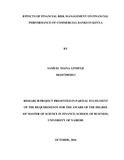| dc.description.abstract | The study sought to determine the effects of financial risk management on financial performance of commercial banks in Kenya. This study adopted a descriptive research design to test the hypothesis over the five year period (2011 to 2015). The population for this study was the 43 commercial banks in Kenya, as at 31st December 2015 including the one that was put under receivership during that financial year. The banks had an aggregate total asset base of Kshs 3.6 trillion and recorded a profit before tax of Kshs 76.7billion as at June 2015. Secondary data from audited financial statements of the 43 commercial banks was collected for the five years period. The central bank requires all banks to publish their audited financial statements publicly on an annual basis. This research employed descriptive statistics to analyze the data collected. The findings of the study indicated that all banks were performing well. There were however big variations in their performance with some posting very high ROA compared to others. The study also found that on predictors of financial performance the variables that had significant influence on each other were bank deposits and liquidity risk (P=0.00), Bank deposit and capital management risk (P=0.031), bank deposit and interest rate risk (P=0.000), liquidity risk and capital management risk (P=0.013), Liquidity risk and bank size (P=0.001), capital management risk and Bank size (P=0.000), capital management Risk and interest rate risk (P=0.046). The study however concluded that the credit risk and foreign exchange risk did not have any significant correlation with any of the variable with (P>0.05). The study concluded that the predictor variables that had an influence on the ROA of the banks were bank deposit with a (P=0.000) and liquidity risk with (P=0.030) while the other predicator variables did not have a significant interest with all having a P>0.05. These include the Credit Risk, capital management risk, bank size and foreign exchange risk. The study found out that as the bank deposits increase the performance of the bank increase, the relationship of the two is infinite, the more it increases the better the bank performs, however banks have an optimal liquidity and when the firm exceeds that point, the performance drops. The banks should ensure that they keep the liquidity at the optimal level. The study recommends that a research should be done on relationship between financial risk management and financial performance of Micro Finance Institution in Kenya and the study recommends that a study should be done on the challenge facing commercial banks in Kenya in management of financial risk management. | en_US |



